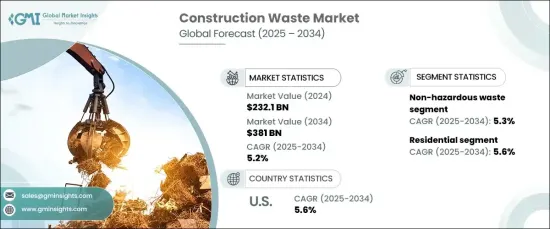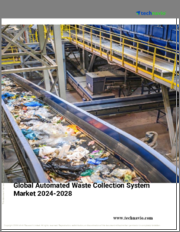
|
시장보고서
상품코드
1665407
건설 폐기물 시장 기회, 성장 촉진요인, 산업 동향 분석, 예측(2024-2032년)Construction Waste Market Opportunity, Growth Drivers, Industry Trend Analysis, and Forecast 2024 - 2032 |
||||||
세계의 건설 폐기물 시장은 2023년에 2,321억 달러로 평가되며, 2025-2034년에 CAGR 5.2%로 확대할 것으로 예측됩니다. 도시화와 인프라 확장 속도가 증가함에 따라 선진국과 개발도상국에서 건설 활동이 눈에 띄게 급증하고 있습니다. 이러한 급속한 발전으로 인해 건설 및 철거 폐기물의 발생량이 크게 증가하여 효율적인 폐기물 관리 솔루션에 대한 수요가 증가하고 있습니다.

세계 각국 정부는 건설 폐기물이 환경에 미치는 영향을 줄이기 위해 엄격한 규제를 도입하고 있습니다. 이러한 정책은 자재 재활용, 매립지 의존도 감소, 지속가능한 관행의 추진에 중점을 두고 있습니다. 또한 순환 경제 원칙을 향한 전 세계적인 움직임은 건축자재 재사용 및 재활용의 중요성을 강조하고 있으며, 이는 시장 성장에 기여하고 있습니다. 그러나 폐기물 분리, 처리 및 재활용과 관련된 높은 비용은 여전히 업계에서 중요한 과제입니다. 특히 강력한 규제적 인센티브가 없는 경우, 많은 기업이 지속가능한 폐기물 관리 방법을 채택하는 데 있으며, 경제적 장벽에 직면하고 있습니다.
| 시장 범위 | |
|---|---|
| 시작연도 | 2023년 |
| 예측연도 | 2024-2032년 |
| 시작 금액 | 2,321억 달러 |
| 예상 금액 | 3,810억 달러 |
| CAGR | 5.2% |
2024년 1,864억 달러를 차지한 비유해 폐기물은 2034년까지 연평균 5.3%의 성장률을 보일 것으로 예상됩니다. 이 부문은 콘크리트, 벽돌, 목재와 같은 재료를 쉽게 재활용할 수 있다는 장점이 있습니다. 또한 환경 친화적인 건축 방법의 채택이 증가하고 있으며, 유해 폐기물이 아닌 다른 폐기물의 재활용을 의무화하는 정부 규정이 이 부문의 성장을 더욱 촉진하고 있습니다.
주택 건설 부문은 2024년 40.6%의 매출 점유율을 차지하며, 2034년까지 연평균 5.6%의 성장률을 나타낼 것으로 예상됩니다. 주택 건설 프로젝트는 특히 신축, 개축 및 철거 과정에서 폐기물 발생에 크게 기여합니다. 저렴한 주택에 대한 노력과 전 세계 도시 인프라 개발의 확대도 이 분야의 폐기물 발생량 증가에 큰 역할을 하고 있습니다.
미국의 건설 폐기물 시장만으로 2024년 441억 달러를 돌파하며, 2034년까지 5.6%의 연평균 복합 성장률(CAGR)을 나타낼 것으로 예상됩니다. 인구 증가와 건설 활동의 활성화가 이러한 증가에 기여하고 있으며, 이 부문은 국가 경제에서 매우 중요한 역할을 하고 있습니다. 건설 사업장이 계속 증가함에 따라 폐기물 관리 솔루션에 대한 수요는 계속 견고할 것으로 예상되며, 시장의 안정적 성장이 예상됩니다.
목차
제1장 조사 방법과 조사 범위
- 시장 범위와 정의
- 기본 추정과 계산
- 예측 파라미터
- 데이터 소스
- 1차 데이터
- 2차 데이터
- 유료 정보원
- 공적 정보원
제2장 개요
제3장 업계 인사이트
- 에코시스템 분석
- 밸류체인에 영향을 미치는 요인
- 이익률 분석
- 파괴
- 향후 전망
- 제조업체
- 유통업체
- 소매업체
- 영향요인
- 촉진요인
- 도시화와 인프라 개발의 증가
- 정부의 규제와 지속가능성 구상
- 건설·해체 활동의 증가
- 업계의 잠재적 리스크 & 과제
- 재활용과 폐기물 관리의 고비용
- 효율적인 재활용·인프라의 결여
- 촉진요인
- 기술 혁신 상황
- 소비자 구매 행동 분석
- 인구통계의 동향
- 구매 결정에 영향을 미치는 요인
- 소비자의 제품 채택
- 선호 유통 채널
- 성장 가능성 분석
- 규제 상황
- 가격 분석
- Porter의 산업 분석
- PESTEL 분석
제4장 경쟁 구도
- 서론
- 기업 점유율 분석
- 경쟁 포지셔닝 매트릭스
- 전략 전망 매트릭스
제5장 시장 추산·예측 : 폐기물 유형별, 2021-2034년
- 주요 동향
- 유해
- 비유해
제6장 시장 추산·예측 : 재료별, 2021-2034년
- 주요 동향
- 토양, 모래, 자갈
- 콘크리트
- 벽돌, 석조
- 목재
- 금속
- 기타
제7장 시장 추산·예측 : 공급원별, 2021-2034년
- 주요 동향
- 주택용
- 상업용
- 산업용
제8장 시장 추산·예측 : 서비스별, 2021-2034년
- 주요 동향
- 수집
- 운송
- 폐기
제9장 시장 추산·예측 : 지역별, 2021-2034년
- 주요 동향
- 북미
- 미국
- 캐나다
- 유럽
- 독일
- 영국
- 프랑스
- 이탈리아
- 스페인
- 아시아태평양
- 중국
- 인도
- 일본
- 한국
- 호주
- 말레이시아
- 인도네시아
- 라틴아메리카
- 브라질
- 멕시코
- 중동 및 아프리카
- 사우디아라비아
- UAE
- 남아프리카공화국
제10장 기업 개요
- Casella Waste Systems, Inc.
- Clean Harbors, Inc.
- Cleanaway Waster Management Limited
- Daiseki Co., Ltd.
- FCC Environment Limited
- GFL Environmental Inc.
- Kiverco
- Metso Corporation
- Remondis
- Renewi plc
- Republic Services
- Veolia Environment S.A.
- Waste Connections
- Windsor Waste
- WM Intellectual Property Holdings, LLC
The Global Construction Waste Market was valued at USD 232.1 billion in 2023 and is projected to expand at a CAGR of 5.2% from 2025 to 2034. The increasing pace of urbanization and infrastructure expansion is driving a notable surge in construction activities across developed and developing regions. This rapid development has led to a significant rise in construction and demolition waste generation, fueling the demand for efficient waste management solutions.

Governments worldwide are introducing stringent regulations to mitigate the environmental impact of construction waste. These policies emphasize recycling materials, reducing landfill dependency, and promoting sustainable practices. Additionally, the global push toward circular economy principles highlights the importance of reusing and recycling construction materials, which is contributing to market growth. However, the high costs associated with waste sorting, processing, and recycling remain a key challenge for the industry. Many companies face financial barriers to adopting sustainable waste management practices, especially in the absence of strong regulatory incentives.
| Market Scope | |
|---|---|
| Start Year | 2023 |
| Forecast Year | 2024-2032 |
| Start Value | $232.1 Billion |
| Forecast Value | $381 Billion |
| CAGR | 5.2% |
Non-hazardous waste, which accounted for USD 186.4 billion in 2024, is expected to grow at a CAGR of 5.3% through 2034. This segment benefits from the ease of recycling materials like concrete, bricks, and wood, which dominate construction and demolition waste streams. Additionally, increasing adoption of eco-friendly building methods and government mandates for recycling non-hazardous waste are further driving this segment's growth.
The residential construction sector secured a 40.6% revenue share in 2024 and is forecasted to grow at a CAGR of 5.6% through 2034. Residential projects contribute heavily to waste generation, especially during new construction, renovation, or demolition activities. The expansion of affordable housing initiatives and urban infrastructure development worldwide are also playing a significant role in driving waste volumes from this segment.
The US construction waste market alone surpassed USD 44.1 billion in 2024, with expectations of a 5.6% CAGR through 2034. Population growth and increased construction activity have contributed to this rise, with the sector playing a pivotal role in the national economy. As construction establishments continue to grow, demand for waste management solutions will likely remain strong, ensuring steady market growth.
Table of Contents
Chapter 1 Methodology & Scope
- 1.1 Market scope & definition
- 1.2 Base estimates & calculations
- 1.3 Forecast parameters
- 1.4 Data sources
- 1.4.1 Primary
- 1.4.2 Secondary
- 1.4.2.1 Paid sources
- 1.4.2.2 Public sources
Chapter 2 Executive Summary
- 2.1 Industry 3600 synopsis, 2021 - 2034
Chapter 3 Industry Insights
- 3.1 Industry ecosystem analysis
- 3.1.1 Factors affecting the value chain
- 3.1.2 Profit margin analysis
- 3.1.3 Disruptions
- 3.1.4 Future outlook
- 3.1.5 Manufacturers
- 3.1.6 Distributors
- 3.1.7 Retailers
- 3.2 Impact forces
- 3.2.1 Growth drivers
- 3.2.1.1 Increase in urbanization and infrastructure development
- 3.2.1.2 Government regulations and sustainability initiatives
- 3.2.1.3 Increasing construction and demolition activities
- 3.2.2 Industry pitfalls & challenges
- 3.2.2.1 High costs of recycling and waste management
- 3.2.2.2 Lack of efficient recycling infrastructure
- 3.2.1 Growth drivers
- 3.3 Technology & innovation landscape
- 3.4 Consumer buying behavior analysis
- 3.4.1 Demographic trends
- 3.4.2 Factors affecting buying decision
- 3.4.3 Consumer product adoption
- 3.4.4 Preferred distribution channel
- 3.5 Growth potential analysis
- 3.6 Regulatory landscape
- 3.7 Pricing analysis
- 3.8 Porter’s analysis
- 3.9 PESTEL analysis
Chapter 4 Competitive Landscape, 2024
- 4.1 Introduction
- 4.2 Company market share analysis
- 4.3 Competitive positioning matrix
- 4.4 Strategic outlook matrix
Chapter 5 Market Estimates & Forecast, By Waste Type, 2021 – 2034, (USD Billion)
- 5.1 Key trends
- 5.2 Hazardous
- 5.3 Non-hazardous
Chapter 6 Market Estimates & Forecast, By Material, 2021 – 2034, (USD Billion)
- 6.1 Key trends
- 6.2 Soil, sand, & gravel
- 6.3 Concrete
- 6.4 Bricks & masonry
- 6.5 Wood
- 6.6 Metal
- 6.7 Others
Chapter 7 Market Estimates & Forecast, By Source, 2021 – 2034, (USD Billion)
- 7.1 Key trends
- 7.2 Residential
- 7.3 Commercial
- 7.4 Industrial
Chapter 8 Market Estimates & Forecast, By Service, 2021 – 2034, (USD Billion)
- 8.1 Key trends
- 8.2 Collection
- 8.3 Transportation
- 8.4 Disposal
Chapter 9 Market Estimates & Forecast, By Region, 2021 – 2034, (USD Billion)
- 9.1 Key trends
- 9.2 North America
- 9.2.1 U.S.
- 9.2.2 Canada
- 9.3 Europe
- 9.3.1 Germany
- 9.3.2 UK
- 9.3.3 France
- 9.3.4 Italy
- 9.3.5 Spain
- 9.4 Asia Pacific
- 9.4.1 China
- 9.4.2 India
- 9.4.3 Japan
- 9.4.4 South Korea
- 9.4.5 Australia
- 9.4.6 Malaysia
- 9.4.7 Indonesia
- 9.5 Latin America
- 9.5.1 Brazil
- 9.5.2 Mexico
- 9.6 MEA
- 9.6.1 Saudi Arabia
- 9.6.2 UAE
- 9.6.3 South Africa
Chapter 10 Company Profiles (Business Overview, Financial Data, Product Landscape, Strategic Outlook, SWOT Analysis)
- 10.1 Casella Waste Systems, Inc.
- 10.2 Clean Harbors, Inc.
- 10.3 Cleanaway Waster Management Limited
- 10.4 Daiseki Co., Ltd.
- 10.5 FCC Environment Limited
- 10.6 GFL Environmental Inc.
- 10.7 Kiverco
- 10.8 Metso Corporation
- 10.9 Remondis
- 10.10 Renewi plc
- 10.11 Republic Services
- 10.12 Veolia Environment S.A.
- 10.13 Waste Connections
- 10.14 Windsor Waste
- 10.15 WM Intellectual Property Holdings, LLC


















